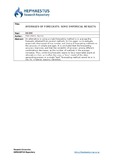Averages of Forecasts: Some Empirical Results
| dc.contributor.author | Makridakis, Spyros | |
| dc.date.accessioned | 2015-12-08T08:01:23Z | |
| dc.date.available | 2015-12-08T08:01:23Z | |
| dc.date.issued | 1983-09 | |
| dc.identifier.issn | 0025-1909 | |
| dc.identifier.uri | http://hdl.handle.net/11728/6363 | |
| dc.description.abstract | An altemative to using a single forecasting method is to average the forecasts obtained from several methods. In this paper we investigate empirically the impact of the number and choice of forecasting methods on the accuracy of simple averages. It is concluded that the forecasting accuracy improves, and that the variability of accuracy among different combinations decreases, as the number of methods in the average increases. Thus, combining forecasts seems to be a reasonable practical altemative when, as is often the case, a "true" model of the data-generating process or a single "best" forecastmg method cannot be or is not, for whatever reasons, identified, | en_UK |
| dc.language.iso | en | en_UK |
| dc.publisher | Informs | en_UK |
| dc.relation.ispartofseries | Management Science; | |
| dc.rights | Informs | en_UK |
| dc.rights.uri | http://creativecommons.org/licenses/by-nc-nd/4.0/ | en_UK |
| dc.source.uri | http://www.jstor.org/stable/2630927 | en_UK |
| dc.subject | Forecasting | en_UK |
| dc.subject | Combined forecats | en_UK |
| dc.subject | Average of forecasts | en_UK |
| dc.title | Averages of Forecasts: Some Empirical Results | en_UK |
| dc.type | Article | en_UK |
Files in this item
This item appears in the following Collection(s)
-
Articles423
Άρθρα


